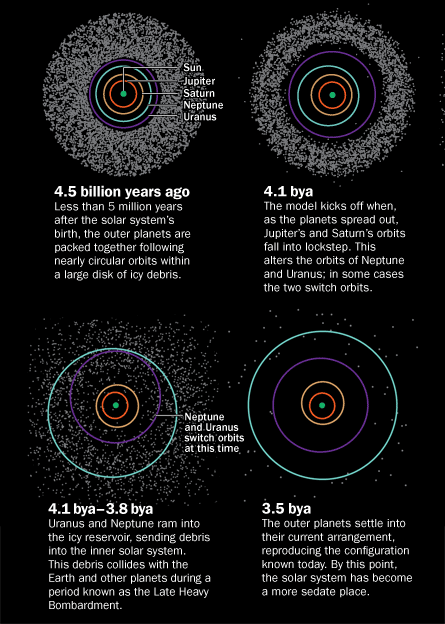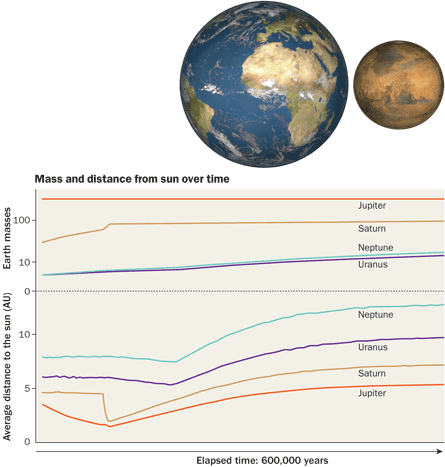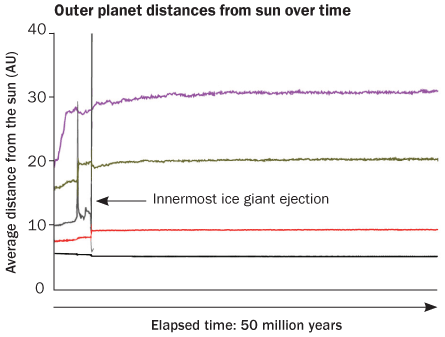Rock, Rattle and Roll
Planetary scientists seek to fill in gaps in outer solar system’s formative years
Most scientists don’t wear protective headgear while giving talks. Then again, most scientists aren’t the target of pastry-wielding colleagues.





But last October, when astronomer Hal Levison presented what he called a “slightly radical” mechanism for building the solar system’s giant planets, he was ready.
“I’m really a little intimidated about the reaction to this,” Levison said, reaching behind the podium and retrieving a baseball catcher’s mask, which he donned during his presentation, at a planetary science meeting in France.
Good thing, because at least one scientist in the audience was amused enough to deliver a good-natured French pastry toss.
Levison, of the Southwest Research Institute in Boulder, Colo., proposed that the giant planets — Jupiter, Saturn, Uranus and Neptune — began forming near the distance at which the Earth currently orbits the sun. One by one, he said, the planet cores grew and shot outward, increasing in size like tumbling snowballs gathering material. Standard ideas describe a much more sedate embryonic environment, with the outer planets growing up simultaneously starting just after the birth of the solar system, roughly 4.5 billion years ago.
Levison’s scenario is one of several recent proposals that seek to color in some gaps in the outer solar system’s past. Some of the proposals complement a widely accepted theory that describes a good chunk of the solar system’s formative years. Other ideas attempt to deal with some apparent snags in the theory, called the Nice model.
Named for the city in France where researchers pulled it together, the Nice story begins once the four giants are fully grown and plants them much closer together. Early chapters include a few million years of the giant siblings jostling and poking one another. The tale’s middle is dominated by a period of extreme turbulence that eventually leads to a cataclysmic rearrangement of the solar system — a dissonance that resolves itself by the system’s billionth birthday, with the giant planets moving into the orbits occupied today.
Though this story explains many observations about the solar system, it doesn’t answer all the questions, such as what happened before the tale begins, how the terrestrial planets survived and why Mars is so small. Recent proposals, including Levison’s tumbling planets idea and a second proposal from another Nice architect, are like a prologue, taking place in the roughly 5 million years after the birth of the solar system, long before the Nice model kicks off. Another tweak seeks to keep the Earth safe from the model’s mid-tale turbulence by introducing a fifth giant planet — a long-lost sibling now wandering through interstellar space.
A Nice story
Reconstructions of the solar system’s early years may benefit from observations of exoplanet systems, evidence contained in asteroids and other small bodies, and future spacecraft visits to the giant planets. But most studies probe this early epoch using the laws of physics to simulate the evolution of planetary orbits, given various starting conditions. “One thing that’s nice about this branch of astronomy is that the physics are understood,” says astronomer Greg Laughlin of the University of California, Santa Cruz, who studies how planetary systems form and evolve. “These guys are all just pulling at each other and interacting with Newtonian gravity.”
Scientists tend to accept a simulated scenario for the early solar system when the most common outcome matches the current planetary configuration. The Nice model — first reported by Levison and his colleagues in 2005 — does that well. It starts with the four giants in a compact configuration between 5.45 times the Earth’s current orbiting distance from the sun, known as an astronomical unit, and 17 times Earth’s orbiting distance.
After several million years, Jupiter’s and Saturn’s orbits evolve into a configuration that upends the adolescent solar system, flinging small bodies inward and scattering Uranus and Neptune out to their current distances. “Things start going all over the place,” says Konstantin Batygin, a graduate student at Caltech who is basing his work on the Nice model.
Neptune ends up where it is now, out at 30 astronomical units. The material hurled toward the inner solar system explains what’s known as the Late Heavy Bombardment, a period dominated by flying comets and asteroids and recorded in cratered scars on bodies such as the moon (SN: 2/14/09, p. 26).
Only after the solar system had been around for about 900 million years did its inhabitants settle into their current locations. The model ends with the planets achieving this stable configuration.
The Nice model also explains the Trojan asteroids orbiting near Jupiter and Neptune, swarms of outer solar system moons in irregular orbits and the icy Kuiper belt, a circle of small, frozen bodies that live beyond the orbit of Neptune.
“This is the only game in town,” says planetary scientist Bill Bottke of the Southwest Research Institute. “There’s no competing model that’s even close to doing any of this.”
Tumbling planets
But the Nice model doesn’t address a crucial element: how to build planetary embryos, the solid seeds that form the cores of planets. Researchers just plunk in finished planets, Levison says of the model’s starting point. “Everybody does this, and they all say this is clearly wrong,” he says. “What happens when you try to do it right?”
Doing it right — that is, trying to capture the whole picture — includes starting ingredients called planetesimals. These asteroid-sized chunks of material float within the protoplanetary disk, knocking into each other and occasionally forming bigger chunks. When those chunks grow to embryos with 10 Earth masses, they begin to wrangle gas from the disk, eventually producing giant planets through what’s known as the “core accretion” process.
Most scientists think that cooking a giant planet begins this way, from the inside out. But some say that growing a giant planet in less than 5 million years — before the gassy disk is known to have disappeared — is problematic.
A seed that starts developing in the thick of the disk, around where Jupiter sits when the Nice model picks up, can become a giant planet relatively quickly, in as little as 3 million years, says planetary scientist David Stevenson of Caltech. Still, the process will take much longer in the outer, colder parts of the disk where Uranus and Neptune live. “You run out of time,” Stevenson says.
Levison’s tumbleplanet theory can solve this timescale problem and get the planets where they need to be before the Nice model begins. Planet embryos forming at one astronomical unit from the sun and moving outward through the disk “grow like gangbusters,” he says, noting that in his still-preliminary calculations, a lunar-sized seed can become a Neptune in about 800,000 years.
Among the more radical implications is that Neptune is the solar system’s most senior citizen, moving outward first. And, contrary to many theories, Jupiter and Saturn did not form anywhere near their current locations.
“The general idea is really quite a way removed from what you will see in textbooks,” Stevenson says.
Rolling planets do introduce some issues, such as how to stop the embryos from migrating beyond the point where the Nice model gets going. Levison and his colleagues are working on solving these issues and developing a full simulation for the idea, but they admit that they don’t have all the answers yet. “I may end up being wrong,” Levison says.
Wandering Jupiter
Levison isn’t the only Nice model architect fiddling with a prologue to the main act. Planetary scientist Alessandro Morbidelli of the Observatoire de la C´te d’Azur in France, who helped construct the model, suggests that the nearly full-grown Jupiter made a little trek inward before settling into its Nice model starting position, 3 or 4 million years after the solar system’s start.
In fact, Jupiter sidled all the way up to where Mars is now, about 1.5 astronomical units from the sun, according to this idea, reported last year in Nature. A big planet like Jupiter would sweep material from the disk at that location, with the leftovers eventually forming Mars. Such housecleaning could explain why Mars is smaller than researchers would expect.
“It explains why, among the terrestrial planets, there is a big difference between the Earth and Mars in terms of mass,” Morbidelli says of the theory, which he calls the Grand Tack.
And the Grand Tack explains more than just a tiny Mars. Jupiter’s inward wandering would have scattered the busted-up chunks sitting in a then-embryonic asteroid belt. When it moved back out, Jupiter would reassemble the rocky swath and drag in a second population of objects from farther away. The product? An asteroid belt between Mars and Jupiter with two distinct types of space rocks, a feature observed today but not explained by the Nice model.
Morbidelli’s next step is to rewind the tape even further and really tackle the process of cooking a giant planet. “The Grand Tack makes some assumptions about where the planets are, which sequence they formed in, and we are not sure these assumptions are correct,” he says. Morbidelli will also help test Levison’s tumbleplanets idea, which may explain the small size of Mars via a different recipe than the Grand Tack (SN Online: 10/4/10).
Planetboot
Some parts of the main act have turned out to be a challenge for the Nice model, too. Over time, its architects discovered a complication. “We ran into a roadblock having to do with the survivability of the Earth,” Levison says. “It ends up hitting Venus, mostly.”
An evil encounter with Jupiter’s gravity during the solar system’s period of rebellion, when planets and asteroids are flying all over the place, sends Earth careening into its sister planet — an undesirable outcome for a model purporting to explain the current state of planetary affairs.
Scientists including David Nesvorny of the Southwest Research Institute proposed that the best way to save Earth was to offer an ice giant — Neptune or Uranus — to the Jovian bully. A larger planet interacting with Jupiter alters Jupiter’s orbit almost instantaneously, causing it to skip over the deadly encounter with Earth.
But when Nesvorny simulated the interaction, he found that Jupiter and Saturn usually expelled the ice giant, leaving behind three giant planets instead of the four currently found in the outer solar system. So he added a fifth giant planet to the young solar system — a sibling who enters a deadly dance with Jupiter, spurring its own ejection and perturbing Jupiter’s and Saturn’s orbits.
Simulations suggest that this ejected fifth planet preserves the solar system observed today when it resides for a short time between Saturn and the ice giants, Nesvorny reported in December in Astrophysical Journal Letters. “I’m able to match the current solar system, starting with five planets, up to 10 times more frequently than starting with just four planets,” Nesvorny says. According to him, a young solar system populated by five giant planets is much more likely than one populated with just four.
“Five-planet systems seem to work better,” Bottke says. “But is there a way we can find a smoking gun telling us that this must be true?”
Batygin, who has also tried saving Earth with what he calls a “sacrificial goat,” thinks such a find is unlikely, since an ejected planet probably wouldn’t carry a detectable signature. In his study, published in Astrophysical Journal Letters in January, Batygin found that the fifth giant wasn’t as necessary to save Earth as Nesvorny reports. “I’d say 50-50,” Batygin says, of the likelihood of a fifth giant being required to save Earth in his model.
Various differences in the scientists’ starting conditions — such as the amount of material the planets are swimming through — might produce the different outcomes. Even if the outcast isn’t necessary to solve the Earth problem, Batygin thinks an extra giant would answer some important questions. “Without a close encounter, Jupiter’s and Saturn’s orbits very rarely end up being what they are today,” Batygin says. “The reason for this fifth planet is to feed the big guys so they can toss it out and be happy.”
As for that lost planet, Batygin doesn’t know where it is today: “I’d like to say in a galaxy far, far away.”
Exo-observations
Scientists observing faraway planetary systems around other stars are turning up data that may fill in the picture of how giant planets are made. “The extrasolar planetary systems are telling us that the basic idea of core accretion is consistent with our understanding,” Laughlin says. Uranus- and Neptune-sized bodies are also turning out to be common, suggesting that they must be easy to make and providing an important clue about how outer planets grow.
Ultimately, the Nice model and scientists’ other ideas will need to work for even Earth’s most distant neighbors. Any story that seeks to explain how the planets are made should explain the ranges of sizes and compositions observed here and elsewhere. It is “dangerous to compare all these models with the solar system only,” Nesvorny says.
Observed exo-architectures have hinted at the ubiquity of planetary reorganizing, demonstrating that sibling scuffles are not hard to provoke. But the planetary configuration of Earth’s nearest and dearest is still somewhat mysterious. So far, “It’s not an enormously common outcome to have a Jupiter-mass planet in a Jupiter orbit,” Laughlin says. But he notes, “We’re just on the threshold of being able to reliably detect true Jupiter analogs around other stars.”
Until more exodata come down from the sky, there are other ways of lending concrete support to simulations’ suggestions. Levison’s tumbleplanet idea makes some testable predictions. One is about the size of planet cores — something that NASA’s Juno spacecraft could help determine when it arrives at Jupiter in 2016. Also, Levison predicts that cores will increase in size with distance from the Sun: Neptune’s and Uranus’ should be larger than Jupiter’s. While it is unlikely to get off the ground anytime soon, a mission to Uranus recently prioritized by the Planetary Sciences Decadal Survey would be able to speak to this prediction.
Though the full recipe for cooking up an outer solar system might one day be written, Laughlin isn’t convinced that humankind will ever really know what happened during the solar system’s youth. The models contain quite a bit of truth, he says, but in the end, they’re just models. Still, “there’s no alternative that does a dramatically better job,” he says. “The world may never know.”